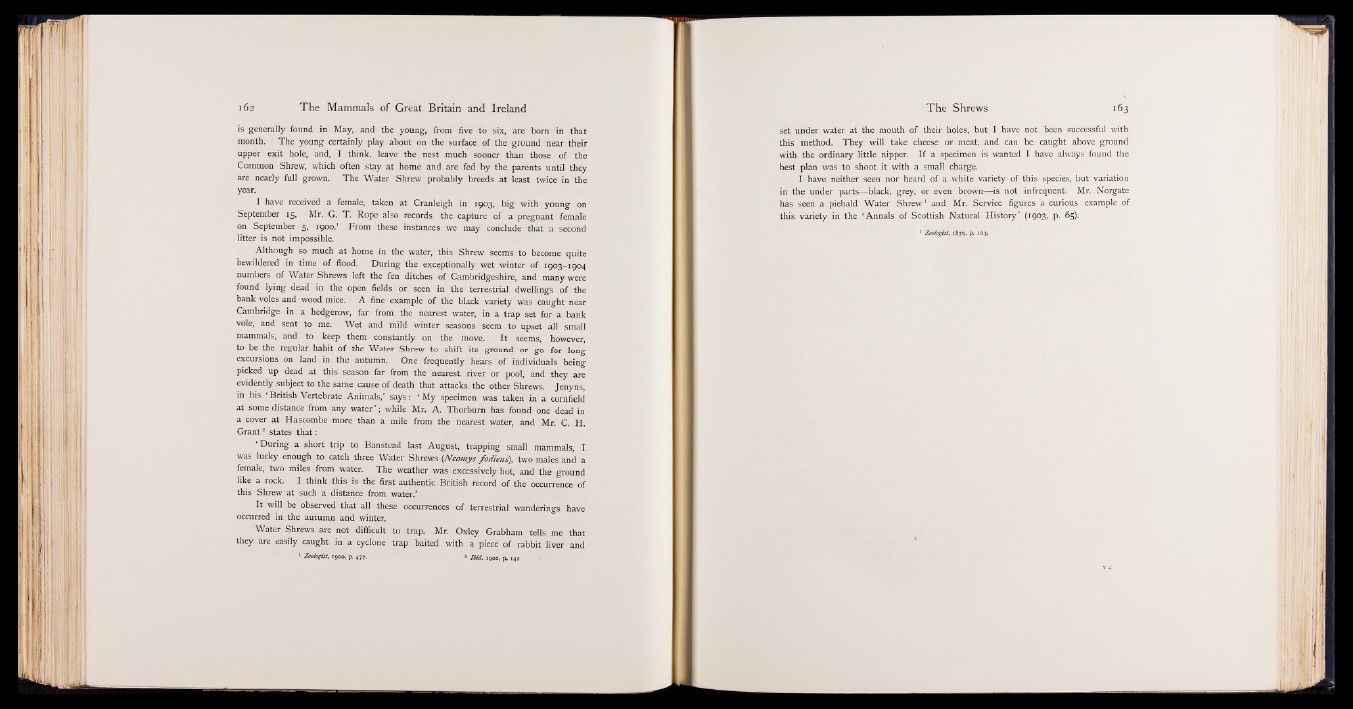
is generally found in May, and the young, from five to six, are born in that
month. The young certainly play about on the surface of the ground near their
upper exit hole, and, I think, leave the nest much sooner than those of the
Common Shrew, which often stay at home and are fed by the parents until they
are nearly full grown. The Water Shrew probably breeds at least twice in the
year.
I have received a female, taken at Cranleigh in 1903, big with young on
September 15. Mr. G. T. Rope also records the capture of a pregnant female
on September 5, 1900.1 From these instances we may conclude that a second
litter is not impossible.
Although so much at home in the water, this Shrew seems to become quite
bewildered in time of flood. During the exceptionally wet winter of 1903-1904
numbers of Water Shrews left the fen ditches of Cambridgeshire, and m a n y were
found lying dead in the open fields or seen in the terrestrial dwellings of the
bank voles and wood mice. A fine example of the black variety was caught near
Cambridge in a hedgerow, far from the nearest water, in a trap set for a bank
vole, and sent to me. Wet and mild winter seasons seem to upset all small
mammals, and to keep them constantly on the move. It seems, however,
to be the regular habit of the Water Shrew to shift its ground or go for long
excursions on land in the autumn. One frequently hears of individuals being
picked up dead at this season far from the nearest river or pool, and they are
evidently subject to the same cause of death that attacks the other Shrews. Jenyns,
in his ‘ British Vertebrate Animals,’ says: ‘ My specimen was taken in a cornfield
at some distance from any water ’ ; while Mr. A. Thorburn has found one dead in
a cover at Hascombe more than a mile from the nearest water, and Mr. C. H.
Grant2 states that:
‘ During a short trip to Banstead last August, trapping small mammals, I
was lucky enough to catch three Water Shrews {Neomys fodiens), two males and a
female, two miles from water. The weather was excessively hot, and the ground
like a rock. I think this is the first authentic British record of the occurrence of
this Shrew at such a distance from water.’
It will be observed that all these occurrences of terrestrial wanderings have
occurred in the autumn and winter.
Water Shrews are not difficult to trap. Mr. Oxley Grabham tells me that
they are easily caught in a cyclone trap baited with a piece of rabbit liver and
1 Zoologist1900, p. 477. 2 Ibid. 1900, p, 142
set under water at the mouth of their holes, but I have not been successful with
this method. They will take cheese or meat, and can be caught above ground
with the ordinary little nipper. If a specimen is wanted I have always found the
best plan was to shoot it with a small charge.
I have neither seen nor heard of a white variety of this species, but variation
in the under parts— black, grey, or even brown— is not infrequent. Mr. Norgate
has seen a piebald Water Shrew1 and Mr. Service figures a curious example of
this variety in the ‘ Annals of Scottish Natural History’ (1903, p. 65).